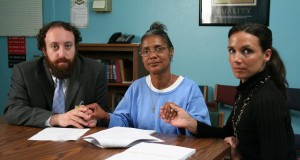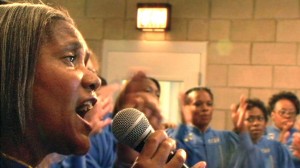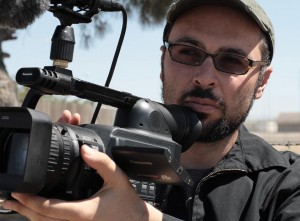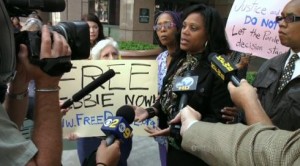Social Workers: “Crime After Crime” Highlights Need for More Resources to End Domestic Abuse

Debbie Peagler (center) and defense team lawyer Joshua Saffran and lawyer and social worker Nadia Costa. Photo courtesy of Life Sentence Films LLC.
Debbie Peagler thought Oliver Wilson was the Prince Charming of Compton, Calif.
But Wilson soon turned abusive, isolating Peagler from family and friends, viciously beating her, and pushing the young mother into a life of prostitution.
Peagler repeatedly called police but got no help. So her family turned to neighborhood gang members to scare Wilson way but these men ended up murdering Wilson. And Peagler’s nightmare worsened when she was sentenced to 25 years to life for being complicit in the crime.
The documentary “Crime After Crime,” which airs on the Oprah Winfrey Network Nov. 3 at 9 p.m. Eastern, follows the efforts of lawyer Joshua Safran and lawyer and social worker Nadia Costa to free Peagler using new evidence and a recently passed California law that allows the effects of domestic violence to be factored into criminal proceedings.
Social workers often help victims of domestic violence. So OWN asked a group of social workers to review “Crime After Crime.”
Our review panelists are: Michelle Blank, a licensed clinical social worker for the Oklahoma Muscogee (Creek) Nation Behavioral Health and Substance Abuse Services; Hiedi Konsol, MSW, LISW-S, a healthcare and mental health social worker in Niles, Ohio; Tanya DePeiza, MSW, LSW, a Chicago social worker who works with senior citizens and formerly incarcerated women through her non-profit Women In Progress Inc.; Richard Lange, LMSW, of Wichita, Kansas, a social service coordinator in the Federal Residential Re-Entry Center for Mirror Inc.; and Jeanine Jones, MSW, assistant professor of social work at Western New Mexico University in Silver City.
Here is their conversation:
Q: On a scale of one to five stars what would you give “Crime After Crime” and why?
Lange: I give it five stars.
Konsol: My movie rating is four out of five stars. I found the movie to be an interesting and honest portrayal of the life and experiences of Debbie Peagler. It allowed the viewer the opportunity to see Debbie in a variety of roles as a teenager, a young woman, a woman victimized by domestic violence, and a woman surviving through the consequences of her life decisions.
DePeiza: I would rate the movie a five because of the grave issues that were faced by Ms. Peagler and the larger issues that were brought to attention of the public regarding the criminal justice system, the penal system, and the challenges that many domestic abuse victims face in both of these systems.
Jones: I would also give it five stars. It dealt with a common social problem and illustrated that without advocacy victims remain in the victim status. Following the case of one woman made the documentary engaging, as well as, educational.
Blank: With five stars being the best, I give “Crime After Crime” five stars. I was on an emotional roller coaster watching this movie – from sadness to anger to disbelief to joy to shock. It was difficult to watch all of the legal injustices Debbie Peagler had to tolerate and the time it took to finally get her out of prison is a travesty. While Debbie Peagler admits to her wrongdoing, the cover-up by the district attorney’s office, the blind eye of the courts, and the time she actually spent in prison, far exceeded the “letter of the law.” I don’t take any of this lightly – my mother was murdered in 1974 when I was 16 years old. I have almost 40 college credits towards a criminal justice degree and I completed a police academy. Since law enforcement in my mom’s case seemed to be involved in a cover-up and no one was really trying to solve her case, I decided to get the training myself with hopes of bringing her killers to justice. I had to come to a very sad realization that there seemed to be no justice in our criminal justice system. I left the criminal justice field and became a social worker more than 25 years ago. Although my mother’s murder remains unsolved 37 years later, I do know I make a positive difference in some people’s lives as a social worker. Victims of domestic violence are already in a prison. Sometimes they get to a breaking point and get out of one prison only to go into a different one. This movie depicts the hell a victim of domestic violence lives in, whether that be the individual’s own home or one operated by the state.

Debbie Peagler leads the prison gospel choir at the Central California Women’s Facility in Chowchilla. Photo courtesy of Life Sentence Films LLC.
Q: I am assuming you all would agree Debbie Peagler’s behavior was typical of a domestic abuse victim. Am I correct?
Blank: Yes it was typical.
Lange: Yes I agree it was typical. Having worked with victims of domestic violence her behavior was very characteristic of a victim. One of the profound comments Debbie made was, she just wanted the abuse to stop.
DePeiza: I have to agree with Michelle and Richard. I believe that her behavior was typical of an abuse victim. At the time of her abuse (the late 1970s) there were little to no resources to assist her and her family with safety that were effective. Domestic violence laws were not strongly in place to offer assistance. Coming from a family where several members had been abused for several years seemed to also affect both her choices and her response to abuse.
Jones: Her early adult behavior was most characteristic of a domestic violence victim. She feared for her life, did not know how to leave and was under the perpetrator’s control emotionally, psychologically and physically. The inner strength she gained while in prison speaks well of her character and the hope that she gained from her attorneys.
Konsol: I think that Debbie’s behavior is not a typical response to the victimization caused by domestic violence, but it was real for her and the only solution that she could envision to survive. I think that it was a drastic response to her situation, but when placed in desperate circumstances it does reflect the basic human drive that we all have to survive.
Q: Do you think this film will further educate the public and criminal justice officials about the plight of domestic abuse victims? Or is there no need for additional changes in laws and regulations regarding domestic abuse victims because there has been more awareness about this issue in the years since Peagler was incarcerated?
Jones: Yes, if they are only willing to listen it could set aside some stereotypes. I was not aware of the California domestic violence law and was pleased to learn of it. One would hope that other states would follow the lead. Too often victims become punished as perpetrators when they attempt to protect themselves. Public awareness is a positive movement but without legal and policy changes the negative behaviors will continue to repeat themselves.
DePeiza: I strongly believe that this film can further educate the public and criminal justice officials. As the rate of women’s incarceration continues to rise, one can conclude that although awareness has increased there are still laws that need to be put in place to help provide protection for women who are domestically abused. Additionally, the issues that surround incarcerated women and their families, along with the impact placed on communities when they do return home, need to continue to be addressed. The issue of domestic abuse and the effects on the family can never have too much exposure.
Lange: The film did an excellent job at showing the need to educate the public along with the criminal justice officials about domestic violence and the victims. There is need for further regulations regarding domestic violence issues. Granted there has been a lot of awareness of domestic violence abuse over the last 20 years but I believe we have only scratched the tip of the iceberg.
Blank: This film will further educate some of the public and criminal justice officials while others will turn a blind eye and a deaf ear to the staggering number of domestic abuse victims. Some won’t notice that the “victims” include not only the individuals being abused but also children in the home, coworkers, employers, neighbors, doctors, nurses, therapists, the court system, communities, and states. In my opinion, most governments still live in the Dark Ages when it pertains to laws and regulations regarding domestic abuse victims.
Konsol: I think “Crime After Crime” will help to continue to educate about the challenges faced by victims of domestic violence. However there is still much to be done to change the systems that have been created to help victims. There has been increased awareness in the overall need to address domestic violence issues over the past several years, but despite awareness, domestic violence continues to plague our society. Awareness and education have made the issue one that is more widely recognized as a problem in society, but there still remains a stigma and an attitude of apathy when an individual is personally affected by the problem. Lack of responsiveness by law enforcement and social service agencies, legal proceedings that re-victimize the victim and an overarching attitude that the victim is responsible for her circumstances still permeate the culture today.
Q: Have you noticed that more law enforcement agencies, prisons and jails are using social workers to help domestic abuse victims? Or does more work need to be done in this area?
Jones: I see little use of social workers by law enforcement with the occasional presentation to law enforcement officers of the dynamics of the problem or volunteer advocates. Social work intervention could help lessen the number of repeat victims of domestic violence if social workers were an integral part of the law enforcement system.
DePeiza: I believe that social workers help to bring more awareness to the agencies mentioned in this question. However, with budget cuts and constraints along with massive case loads, effective change and advocacy are not always implemented. Law enforcement agencies, prisons, jails, and lawmakers should have continued partnerships with social workers so that advocacy and empowerment can be provided for victims, their families, and when possible, the abusers. Though crimes warrant the appropriate punishment, this society is too “penal” focused and often fails to see other factors that contribute to what lands them in prison. With a definitive yes, more work needs to be done in this area.
Lange: My practice is in the criminal justice system arena. Working in the criminal justice area overall there is an absence of social workers across the board. Social workers can have a greater impact within the criminal justice area due to our understanding of social justice, dignity and worth of the person, and importance of human relationships. When a person is sent to prison these core values are taken away from the individual.
Konsol: Social workers recently have become more involved in the judicial system and with services that advocate for the victim and treat the perpetrator. However, there is still much work to be done in this area. From a professional perspective, I have experienced there are very few social workers that have been afforded the opportunity to work in the area of domestic violence due to the lack of training, personnel, financial resources and overall supports for these types of services. There are more animal shelters than domestic violence shelters in most states. Those states that do have shelter services for victims of domestic violence often have very little resources to address the non-traditional victim, offering little to nothing to victims of domestic violence who are in same sex relationships and even more specifically men who are affected by the issue of domestic violence. For change to occur, changing society’s view domestic violence must occur. Domestic violence should be viewed for what it is, a crime of violence and not a crime of gender.
Blank: In some geographic areas, one can see that law enforcement agencies, prisons, and jails are using social workers to help domestic abuse victims. However, in rural areas like where I live and work the number of trained and qualified social workers is minimal, caseloads are high, resources are stretched or non-existent, and sadly states are starting to do away with programs and laws that help domestic abuse victims due to budget constraints. Once again, our society seems to be leaning more towards seeing people only as numbers and/or dollar signs. Work will always be needed in this area. Times are hard and people are getting more stressed, overwhelmed, irritable and desperate. Unfortunately, when this happens, abusers tend to see those around them as convenient punching bags. We MUST continue making people aware of the plight of domestic abuse victims. Otherwise, many victims will remain victims, some will resort to using and abusing drugs and alcohol while others will abuse their children, join gangs, resort to crime or like Debbie Peagler in “Crime After Crime” end up behind bars in a prison because they finally had enough and fought back only to be victimized again.
SocialWorkersSpeak.org interviewed “Crime After Crime” director Yoav Potash about the film and role lawyer and social worker Nadia Costa played in the film. To read article click here. And to learn more about how social workers help domestic violence victims visit the National Association of Social Workers’ “Help Starts Here” Domestic Violence Webpage by clicking here.
| Leave A CommentAdvertisement
2 Comments
Leave a Comment
You must be logged in to post a comment.






Thank you all so much for bringing this most important under discussed social problem to the forefront. I was a victim once. That man continued to hurt others until he finally ended up in jail. He is now out and repeating the same. That was nearly 10 years ago. I still have daily pain from the injuries. Our social workers do a difficult most needed job. Again, I Thank you.
THE FILM COMES OUT ON DVD ON APRIL 24, 2012.